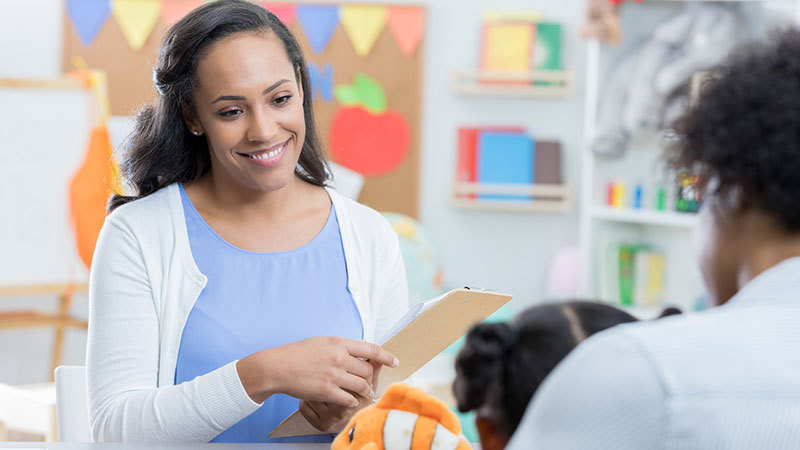I had taught art for eight years and was making the leap to teach second- and third-graders. As I prepared to teach reading, writing, and math instead of the elements of design and color theory, I was overly nervous. I turned to my principal for guidance on how to be an effective classroom teacher. He gave me one piece of advice: “Pick up the phone and call your parents regularly.”
That’s it? What about how to teach these little people how to read? Wasn’t learning how to problem solve with numbers more important?How am I supposed to set up a writer’s workshop when I’m not sure where to start with writing instruction?
It seemed like answering my questions was far more important than calling parents. But when I pressed him for a different response, he said, “Calling parents is one of the most important things you can do.”
Parent-Teacher Communication: Why It Matters
Over half of my first class qualified for free or reduced lunch, one-third of the students had displayed significant behavior issues in previous years, multiple students had an IEP (four needed a referral), two students were repeating third grade, and two-thirds of the students came from single-parent homes. Did I mention that I had the youngest child of one of the Board of Education members? No pressure, right?
Those first telephone calls were excruciating to initiate since I was a bashful introvert, but I forced myself to do it. I immediately saw that my principal was right. Communicating with parents and guardians is one of the most important things an educator can do.
Why is that?
First, we must understand the power of relationships. The most basic of human instincts is to feel a connection. It’s no secret that when a teacher creates positive relationships with students, students will do better in school. Many studies indicate that if a meaningful connection can be made between home and school, student achievement will increase.
In today’s time, initiating and maintaining communication between home and school can be challenging. Posting a newsletter or blog online does not guarantee it will get read, especially if it’s the same information from the previous week with only minor changes. Plus, that newsletter or blog is generic and one-way communication. The only ones who will read it, faithfully, are the families who are most involved. And the students of those families will have a successful school experience regardless of the communication or lack of communication that occurs.
But what about the students whose families are less involved? Chances are, their parents are those with whom communication is most difficult, but that’s where your attention is needed the most. If the job of schools is for every child to be successful, then we must communicate to all families, not just some.
As a principal later in my career, I watched teachers masterfully maintain communication with all types of families. The key to the success was making it personal and not generic, meaningful and not negative, and finding a way to make the connection regularly with families. The result? Students in those classrooms achieved at higher levels than others.
Recently, a former graduate student of mine who is a middle school special education teacher told me about a difficult meeting with a parent whose child had a long history of disruptive behavior. After addressing disciplinary concerns, the teacher and mother developed a communication plan to address behavior and achievement. Because the mother was overwhelmed with other children and her job, being consistent in communicating with school was practically impossible.
But the teacher made the plan easy for her by setting up regular text message updates to keep her informed about her son’s behavior and achievement. She even texted randomly when the student did something right in the classroom and let the student see the message. Guess what. After multiple exchanges, the mother looked forward to hearing from the school, and the student’s performance improved. A positive relationship had been made between the student and, now, the mother.
Initiating the Connection
Keeping families informed. Isn’t that the heart of home-school communication? Conventional forms of communication, like newsletters, blogs, and report cards have their place for providing general information and school news. But to truly connect and inform families effectively, educators must build a relationship that allows two-way communication.
When I made those first phone calls years ago, the families of my most challenging students were wary when I identified myself. Their immediate response was guarded. When I said I was calling just to check in, they were dumbfounded. And when I told them something positive about their child, purposely leaving out any negative comments, they were speechless.
As a result, they were more eager to talk, the next time I called. For the parents who didn’t (or wouldn’t) answer their phones, I left a message telling them that I wanted to talk to them about a great thing that their child had done. Every single one of them called me back. I always gave my home number and found that parents never took advantage of having it.
Granted, it sometimes takes some creativity to find positive words for intensive children, but they deserve and need praise as much as anyone else, if not more. Communicating the good stories helps strengthen the relationship, so when you have to discuss the bad, resolutions are discussed more easily.
And as for the board member, he said it was the first time out of three children’s school experiences that a teacher had ever called “just to check in.” He wasn’t the last parent to tell me that. I continued the calls as principal and got the same reactions and unwavering future support from families.
Most problems in life can be tied back poor communication. Why wouldn’t we want to do all that we can do to keep communicate open and on-going with parents?
Make the call. It is one of the most important keys to school success for students – all students.








